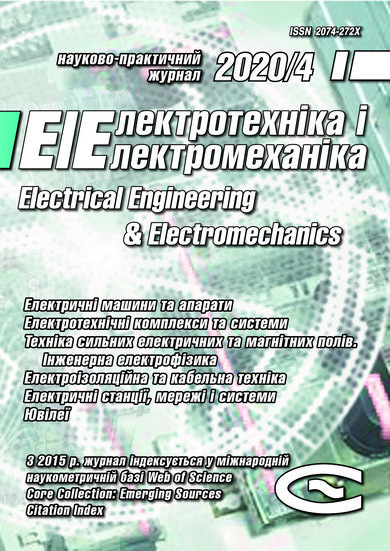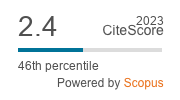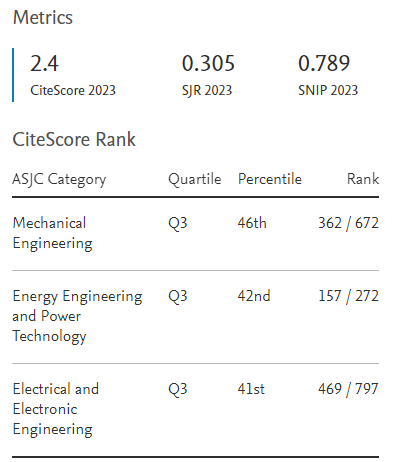EXCITATION WITH A SERIES OF PULSES OF A LINEAR PULSE ELECTRODYNAMIC TYPE CONVERTER OPERATING IN POWER AND HIGH-SPEED MODES
DOI:
https://doi.org/10.20998/2074-272X.2020.4.01Keywords:
linear pulse electrodynamic type converter, mathematical model, high-speed and force operation mode, excitation by a series of pulses, recoil force, efficiency criterionAbstract
Purpose. The aim of the article is to increase the efficiency of linear pulse electrodynamic type converter (LPEC) when operating in high-speed and force modes by reducing the amplitude of the recoil force by exciting its windings with a series of pulses from the capacitive energy storage (CES). Methodology. Using the LPEC mathematical model, in which the equations describing the interconnected electrical, magnetic, mechanical and thermal processes are presented in a recursive form, the electrodynamic and electromechanical characteristics of LPEC are simulated by excitation by a single and a series of pulses from CES sections. Results. It was found that when a single pulse is excited by an LPEC operating in a high-speed mode, in which the armature accelerates the actuator, compared with the force mode in which the armature is inhibited, the current amplitude in the windings decreases by 7.5 %, and the amplitudes of electrodynamic force (EDF) – by 21.8 %, impulse values of EDF – by 27.1 %. In this case, the armature winding with the actuating element accelerates to a speed of 7.1 m/s. When excited by a series of pulses from the same sections of the CES during LPEC operation in the force mode, the amplitudes of the current pulses and the EDF are practically unchanged, and when operating in high-speed mode, the amplitudes of the currents and the EDF gradually decrease. Both in power and in high-speed operating modes, an increase in the number of excitation pulses while conserving the energy of the CES leads to a decrease in the main indicators of LPEC. But by reducing the amplitude of the EDF, which manifests itself as a recoil force, the efficiency of LPEC increases. Originality. It is shown that the excitation of LPEC by a series of pulses increases the efficiency of LPEC when operating in high-speed and power modes, providing a minimum amplitude of the EDF, which determines the recoil force acting on the inductor winding. Practical value. For LPEC operating in high-speed mode, it is proposed to reduce the maximum current amplitudes and EDF due to the sequential increase in capacitances of sections of the CES, forming a series of excitation pulses. For LPEC, operating in force mode, it is advisable to use the same capacities of all sections of the CES.References
Bissal A., Magnusson J., Engdahl G. Comparison of two ultra-fast actuator concept. IEEE Transactions on Magnetics, 2012, vol. 48, no. 11, pp. 3315-3318. doi: 10.1109/tmag.2012.2198447.
Tomashevsky D.N., Koshkin A.N. Modeling of linear impulse electric motors. Russian Electrical Engineering, 2006, no. 1, pp. 24-27. (Rus).
J. Young-woo, L. Hyun-wook, L. Seok-won. High-speed AC circuit breaker and high-speed OCD. Proceeding of the conf. «22-th international conference on electricity distribution». 2013, 10-13 June,Stockholm. – Paper 608.
D.-K. Lim, D.-K. Woo, I.-W. Kim, D.-K. Shin, J.-S. Ro, T.-K. Chung, H.-K. Jung. Characteristic Analysis and Design of a Thomson Coil Actuator Using an Analytic Method and a Numerical Method. IEEE Transactions on Magnetics, 2013, vol. 49, no. 12, pp. 5749-5755. doi: 10.1109/tmag.2013.2272561.
Puumala V., Kettunen L. Electromagnetic design of ultrafast electromechanical switches. IEEE Transactions on Power Delivery, 2015, vol. 30, no. 3, pp. 1104-1109. doi: 10.1109/TPWRD.2014.2362996.
Bolyukh V.F., Kashanskij Yu.V., Schukin I.S. Influence of geometrical parameters of the inductor and armature on the indicators of a linear pulse electromechanical converter of an electrodynamic type. Electrical engineering & electromechanics, 2019, no. 3, pp. 11-17. doi: 10.20998/2074-272X.2019.3.02.
Bolyukh V.F., Kashanskyi Yu.V., Shchukin I.S. Comparative analysis of power and speed indicators linear pulse electromechanical converters electrodynamic and induction types. Technical electrodynamics, 2019, no. 6, pp. 35-42. (Rus). doi: 10.15407/techned2019.06.035.
Bolyukh V.F., Oleksenko S.V., Shchukin I.S. Comparative analysis of linear pulse electromechanical converters electromagnetic and induction types. Technical electrodynamics, 2016, no. 5, pp. 46-48. (Rus). doi: 10.15407/techned2016.05.046.
Mishkin V.N., Tolstik A.I. Comparative evaluation of arresting devices on the electrodynamic and electromagnetic principle of action. Electromagnetic pulse systems, 1989, pp. 114-117. (Rus).
Balikci A., Zabar Z., Birenbaum L., Czarkowski D. Improved performance of linear induction launchers. IEEE Transactions on Magnetics, 2005, vol. 41, no. 1, pp. 171-175. doi: 10.1109/tmag.2004.839283.
Abdalla M.A., Mohamed H.M. Asymmetric multistage synchronous inductive coilgun for length reduction, higher muzzle velocity and launching time reduction. IEEE Transactions on Plasma Science, 2016, vol. 44, no. 5, pp. 785-789. doi: 10.1109/TPS.2016.2543500.
Bolyukh V.F., Vinnichenko A.I. Concept of an induction-dynamic catapult for a ballistic laser gravimeter. Measurement Techniques, 2014, vol. 56, iss. 10, pp. 1098-1104. doi: 10.1007/s11018-014-0337-z.
Bolyukh V.F., Omel’chenko A.V., Vinnichenko A.I. Effect of self-seismic oscillations of the foundation on the readout of a ballistic gravimeter with an induction-dynamic catapult. Measurement Techniques, 2015, vol. 58, no. 2, pp. 137-142. doi: 10.1007/s11018-015-0675-5.
Zhou Y., Huang Y., Wen W., Lu J., Cheng T., Gaoet S. Research on a novel drive unit of fast mechanical switch with modular double capacitors. Journal of Engineering, 2019, vol. 2019, no. 17, pp. 4345-4348. doi: 10.1049/joe.2018.8148.
Fan G., Wang Y., Hu Y., Yan Z. Research on energy recovery system based on HTSM for synchronous induction electromagnetic launcher system. IEEE Transaction on Plasma Science, 2020, vol. 48, no. 1, pp. 291-298. doi: 10.1109/TPS.2019.2960038.
Guangcheng F., Wang Y., Xu Q., Xinyi N., Yan Z. Design and analysis of a novel three-coil reconnection electromagnetic launcher. IEEE Transactions on Plasma Science, 2019, vol. 47, no. 1, pp. 814-820. doi: 10.1109/TPS.2018.2874287.
Niu X., Li W., Feng J. Nonparametric modeling and parameter optimization of multistage synchronous induction coilgun. IEEE Transactions on Plasma Science, 2019, vol. 47, no. 7, pp. 3246-3255. doi: 10.1109/TPS.2019.2918157.
Bolyukh V.F., Katkov I.I. Influence of the Form of Pulse of Excitation on the Speed and Power Parameters of the Linear Pulse Electromechanical Converter of the Induction Type. Volume 2B: Advanced Manufacturing, Nov. 2019, 8 p. doi: 10.1115/IMECE2019-10388.
Liu X., Yu X., Ban R., Li Z. Analysis of the capacitor-aided meat grinder circuits for an inductive pulsed power supply. IEEE Transactions on Plasma Science, 2017, vol. 45, no. 7, pp. 1339-1346. doi: 10.1109/TPS.2017.2705179.
Bolyukh V.F., Shchukin I.S. The thermal state of an electromechanical induction converter with impact action in the cyclic operation mode. Russian electrical engineering, 2012, vol.83, no.10, pp. 571-576. doi: 10.3103/s1068371212100045.
Vilchis-Rodriguez D.S., Shuttleworth R., Barnes M. Experimental Validation of a Finite Element 2D Axial Thomson Coil Model with Inductance and Resistance Compensation. 13th IET International Conference on AC and DC Power Transmission (ACDC 2017), 2017, Manchester, UK, 14-16 Feb. 2017. doi: 10.1049/cp.2017.0032.
Yadong Z., Ying W., Jiangjun R. Capacitor-driven coil-gun scaling relationships. IEEE Transactions on Plasma Science, 2011, vol. 39, no. 1, pp. 220-224. doi: 10.1109/TPS.2010.2052266.
Downloads
Published
How to Cite
Issue
Section
License
Copyright (c) 2020 V. F. Bolyukh, I. S. Schukin

This work is licensed under a Creative Commons Attribution-NonCommercial 4.0 International License.
Authors who publish with this journal agree to the following terms:
1. Authors retain copyright and grant the journal right of first publication with the work simultaneously licensed under a Creative Commons Attribution License that allows others to share the work with an acknowledgement of the work's authorship and initial publication in this journal.
2. Authors are able to enter into separate, additional contractual arrangements for the non-exclusive distribution of the journal's published version of the work (e.g., post it to an institutional repository or publish it in a book), with an acknowledgement of its initial publication in this journal.
3. Authors are permitted and encouraged to post their work online (e.g., in institutional repositories or on their website) prior to and during the submission process, as it can lead to productive exchanges, as well as earlier and greater citation of published work.





